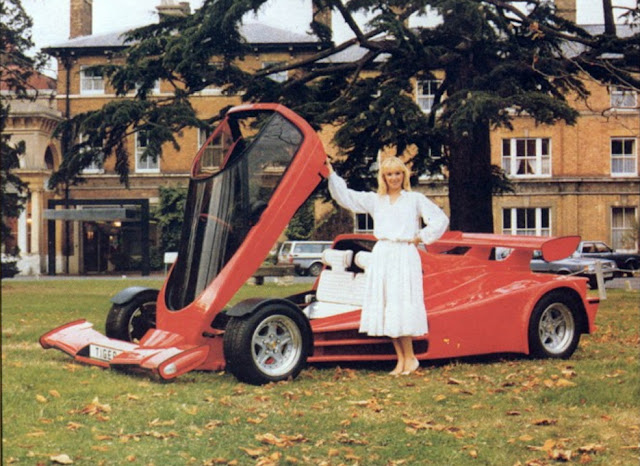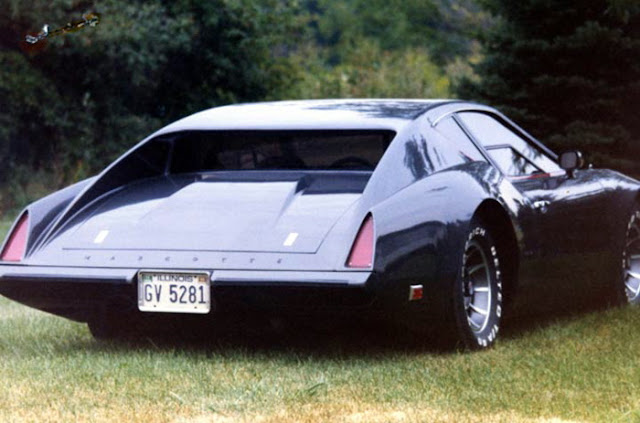T.I.G.E.R. an F1 car for the street
The Cartel T.I.G.E.R. was created by noted designer Chris Humberstone and made its debut in 1983. He had quite the portfolio by that time. His first commercial car design was a body kit for the BMC Mini marketed by Scorpion Car Company, which he penned at the age of 21. He followed that with the Imp based Humberstone Sports 408, the Owen Sedanca, and a number of designs under the Rapport brand including the Jaguar powered Forte.
Chris Humberstone could be considered a peer and contemporary of Richard Oakes, known for his Nova and Midas designs, and was nearly as prolific. He also owned Spice Racing Cars and designed racecars for Benetton, Force F1, and Brun Technics. Sadly his illustrious career was cut short by his untimely death in 1999.
 |
| Designer, Chris Humberstone, with a model of the Owen Sedanca |
The story of the T.I.G.E.R., which stood for 'Turbine Intercooled Ground Effect Roadster', began with a trip Humberstone took to attend the Auto-Expo convention in America. While there, he got into a conversation with another attendee about an intriguing idea. They discussed the feasibility and potential of a sportscar that would take the spartan theme of the Lotus 7 in a modern direction. The more they talked the more convinced he became of its merits.
Back in the UK, he penned a wedge shaped car that employed ground-effect aerodynamics, could seat 2 in relative comfort, in a mid-engine configuration. It looked quite a bit like a contemporary Formula One car but was intended for the street. The design also included a forward hinged, one piece canopy for entry and egress. Comprising the top half of the car's nose and its windshield, the canopy integrated the gauge cluster and steering column, all of which lifted as a unit.
During the initial development of the car, it went through a number of iterations in clay before the T.I.G.E.R. design was finalized. Then the engineering of the prototype began. One of the foremost considerations was how to balance durability versus weight in the body and chassis. Humberstone determined that steel and aluminum were too heavy for construction of the body and fiberglass wasn't strong enough in his view.
The choice was made to use a new aramid material, created by Dupont, called Kevlar. Used in body armor and bulletproof cars, it offers tremendous strength and durability. Partner Cartel had already gained experience using the material in armored cars for dignitaries, business tycoons, as well as the Pope so they were certainly up to the task.
As the T.I.G.E.R. was designed with the American market in mind, a US sourced V8 seemed like a natural choice but no willing supplier was found. So Cartel elected to go with the ubiquitous Renault PRV, a 2.6 liter motor which saw service in everything from the R25 to the Alpine Renault A310 and DeLorean. Both the normally aspirated and turbocharged versions of the engine would be offered with output reaching 170-200bhp. In a car tipping the scale at 1300lbs, this would deliver potent performance.
Cartel worked with well-known Formula Ford constructor, Lester Ray, to design and build the spaceframe chassis in tubular steel. The car's fully independent suspension consisted of unequal length wishbones with top mounted rocker arms actuating coil springs and dampers at all four corners. Rack and pinion steering and 10.5" ventilated disc brakes with four pot calipers rounded out the package.
 |
| The T.I.G.E.R. |
In keeping with the T.I.G.E.R. moniker, the car's "ground-effect" aerodynamics were achieved by forcing air through twin channels within the bodywork to either side of the engine and transaxle. This created a vortex that sucked the car to the ground. As with Formula One racecars, this aerodynamic effect increased with speed, adding as much as 1000lbs of downforce. Cartel enlisted local racecar engineer Ken Tyrrell, whose facilities were just down the road, as a consultant on the project in order to fine tune this aspect of the design.
Another clever aspect of the design was its headlight arrangement. The lights were built into the integrated wing/bumper that was mounted at the front of the car. On each end of the wing a rotating section housed the headlights, facing downward out of sight. When required, these units rotated up at a 40 degree angle, so as to face forward.
Cartel planned to sell 200 units per year in the UK at a price between £8,000 - £10,000 but, sadly the project never came to fruition. It appears that the car proved too expensive to produce at a profit and the company opted to focus on their lucrative armored car and automotive accessory lines of business.
The fate of the prototype is unknown but, given Cartel's typical clientele, it may have been sold to a middle eastern customer. That might explain its disappearance from public view. This author has found no record, to date, of it being shown beyond the mid 80's.
The fate of the prototype is unknown but, given Cartel's typical clientele, it may have been sold to a middle eastern customer. That might explain its disappearance from public view. This author has found no record, to date, of it being shown beyond the mid 80's.
Sources:
Rapport Forte (fan site)
Rapport Forte (fan site)








Are there any known plans, drawings, schematics or construction information that is available on the Cartel T. I. G. E. R?
ReplyDeleteRandom non spam comment. Why dont you spammers get a real job.
ReplyDeleteAnyway, formula 1 car for the street, where have I heard that before?
The problem with that concept is all the other vehicles are not formula 1 cars, some are 3 ton SUVs, others are 40 ton semis with trailers, and the roads dont have run off areas nor safety marshalls.
Dont bother with seat belts, hopefully youll be thrown clear of the wreckage and walk away unscathed.